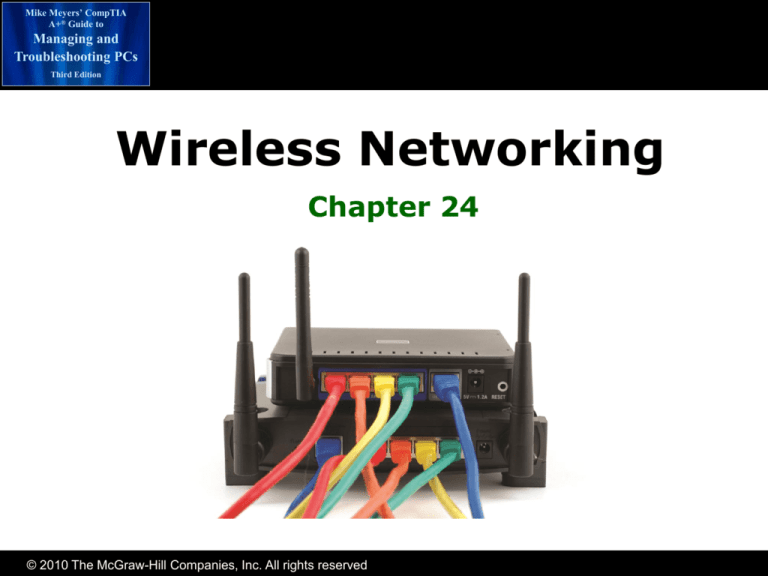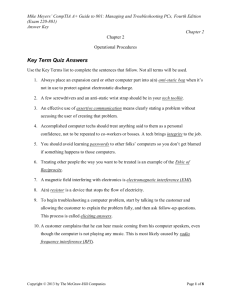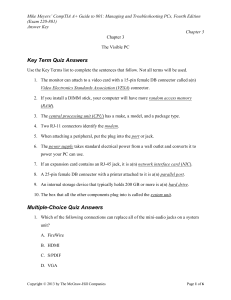
Mike Meyers’ CompTIA
A+® Guide to
Managing and
Troubleshooting PCs
Third Edition
Wireless Networking
Chapter 24
© 2010 The McGraw-Hill Companies, Inc. All rights reserved
Mike Meyers’ CompTIA
A+® Guide to
Managing and
Troubleshooting PCs
Overview
Third Edition
• In this chapter, you will learn how to
– Discuss wireless networking components
– Analyze and explain wireless networking standards
– Install and configure wireless networks
– Troubleshoot wireless networks
© 2010 The McGraw-Hill Companies, Inc. All rights reserved
Mike Meyers’ CompTIA
A+® Guide to
Managing and
Troubleshooting PCs
Wireless Technology Options
Third Edition
• Users who want to go wireless have
many options today
– 802.11 (Wi-Fi) and Bluetooth use radio waves to
connect devices
– Infrared devices connect using light waves
– Cellular telephone companies offer Internet
connectivity through cell phone networks
© 2010 The McGraw-Hill Companies, Inc. All rights reserved
Mike Meyers’ CompTIA
A+® Guide to
Managing and
Troubleshooting PCs
Wireless Networking Components
Third Edition
• Capabilities built into many devices
today
– Laptops, PDAs, even some desktops come with
built-in wireless
© 2010 The McGraw-Hill Companies, Inc. All rights reserved
Mike Meyers’ CompTIA
A+® Guide to
Managing and
Troubleshooting PCs
Third Edition
Wireless Networking Components
(continued)
• Wireless Ethernet and Bluetooth often
integrated or can easily be added
– USB, PCI, PCI Express, or PC Card adapters
© 2010 The McGraw-Hill Companies, Inc. All rights reserved
Mike Meyers’ CompTIA
A+® Guide to
Managing and
Troubleshooting PCs
Third Edition
Wireless Networking Components
(continued)
• Wireless access point (WAP)
– Wireless Ethernet devices can connect to a WAP
– Acts like a hub to the wireless hosts in the area
• Bluetooth hub
– Built-in option on many
newer PCs
© 2010 The McGraw-Hill Companies, Inc. All rights reserved
Mike Meyers’ CompTIA
A+® Guide to
Managing and
Troubleshooting PCs
Wireless Networking Software
Third Edition
• Wireless devices use the same
networking clients and protocols as
wired networks
– Use CSMA/CA (CA stands for collision avoidance)
• Another option is using Request to Send/Clear to Send
(RTS/CTS)
• Sending node issues an RTS to the receiving node as
a request
• Receiving node replies with a CTS when it’s clear
• Once data is received, receiving node sends an ACK
(acknowledgment)
© 2010 The McGraw-Hill Companies, Inc. All rights reserved
Mike Meyers’ CompTIA
A+® Guide to
Managing and
Troubleshooting PCs
Wireless Configuration Utility
Third Edition
• Configure wireless networking software
– Use a utility to configure parameters
• Windows built-in utility or vendor provided
• Set parameters like network name
© 2010 The McGraw-Hill Companies, Inc. All rights reserved
Mike Meyers’ CompTIA
A+® Guide to
Managing and
Troubleshooting PCs
Wireless Networking Modes
Third Edition
• Ad-hoc mode
– Each wireless node is in direct
contact with every other node
in a decentralized free-for-all
– Form an Independent Basic
Service Set (IBSS)
– Called peer-to-peer mode
– Good for a few
computers or temporary
network such as study
groups or business
meetings
© 2010 The McGraw-Hill Companies, Inc. All rights reserved
Mike Meyers’ CompTIA
A+® Guide to
Managing and
Troubleshooting PCs
Third Edition
Wireless Networking Modes
(continued)
• Infrastructure Mode
– Use one or more WAPs to
connect wireless nodes to
a wired network segment
– A single WAP servicing an
area is called a Basic
Service Set (BSS)
– Additional WAPs create an
Extended Basic Service
Set (EBSS)
© 2010 The McGraw-Hill Companies, Inc. All rights reserved
Mike Meyers’ CompTIA
A+® Guide to
Managing and
Troubleshooting PCs
Wireless Networking Security
Third Edition
• Four methods used to enhance security
– Change the default password on the WAP
– Configure Service Set Identifier (SSID)
• That’s the name of the wireless network (like a
workgroup or domain name)
– Filter by MAC address
– Use encryption
• Let’s look at all four methods
© 2010 The McGraw-Hill Companies, Inc. All rights reserved
Mike Meyers’ CompTIA
A+® Guide to
Managing and
Troubleshooting PCs
Third Edition
Wireless Networking Security
(continued)
• Default password is common knowledge
for every WAP manufacturer
– Change this as soon as you start the set up
• Service Set Identifier (SSID)
–
–
–
–
–
Configure a unique SSID or network name
Default is often name of vendor such as “Linksys”
Widely known so easy to guess
Each node needs to have the same SSID
Can turn off SSID broadcasting
© 2010 The McGraw-Hill Companies, Inc. All rights reserved
Mike Meyers’ CompTIA
A+® Guide to
Managing and
Troubleshooting PCs
Third Edition
Wireless Networking Security
(continued)
• MAC filtering
– Filtering based on each host’s unique MAC address
– Creates a type of accepted user
– Some WAPs enable you to blacklist specific MAC
addresses too
• WAPs use an access control list (ACL) for
authentication
– MAC address filtering is a great example of this
– This ACL has nothing to do with NTFS
© 2010 The McGraw-Hill Companies, Inc. All rights reserved
Mike Meyers’ CompTIA
A+® Guide to
Managing and
Troubleshooting PCs
Third Edition
Wireless Networking Security
(continued)
• Wired Equivalency Privacy (WEP)
– Encrypts data using 40-bit or 104-bit encryption
– Provides authentication based on MAC addresses
– Significant flaws
• Wi-Fi Protected Access (WPA)
– Interim security upgrade to WEP
– Uses encryption key integrity-checking through
Extensible Authentication Protocol (EAP)
– Uses RC4 encryption
• WPA2 (IEEE 802.11i )
– Full security upgrade from WEP and WPA
– Significant improvements
– Uses AES encryption
© 2010 The McGraw-Hill Companies, Inc. All rights reserved
Mike Meyers’ CompTIA
A+® Guide to
Managing and
Troubleshooting PCs
Speed and Range Issues
Third Edition
• Wireless speeds range from 2 Mbps to
100+ Mbps
• Speed affected by range
–
–
–
–
–
–
Speed dynamically negotiated
Maximum throughput at approximately 25 feet or less
At edge of range, throughput may decrease to 1 Mbps
Range not exact
Often listed as around 150 feet or 300 feet
Dead spots and interfering devices can affect signal
• Just add a WAP to extend the range
© 2010 The McGraw-Hill Companies, Inc. All rights reserved
Mike Meyers’ CompTIA
A+® Guide to
Managing and
Troubleshooting PCs
Wireless Networking Standards
Third Edition
• 802.11-based wireless networking
– Most common and fastest of the options for
wireless networking
© 2010 The McGraw-Hill Companies, Inc. All rights reserved
Mike Meyers’ CompTIA
A+® Guide to
Managing and
Troubleshooting PCs
Third Edition
Wireless Networking Standards
(continued)
• 802.11a offers short range, but high
speed and low interference with other
devices
–
–
–
–
~150’ range
54 Mbps throughput
Runs at the 5-GHz frequency
Not compatible with any other Wi-Fi standards
• 802.11b was the first, so slowest
connection
– ~300’ range
– 11 Mbps throughput
– Runs at the 2.4-GHz frequency
© 2010 The McGraw-Hill Companies, Inc. All rights reserved
Mike Meyers’ CompTIA
A+® Guide to
Managing and
Troubleshooting PCs
Third Edition
Wireless Networking Standards
(continued)
• 802.11g matches 802.11a’s speed and
provides backward compatibility for
802.11b devices
– ~300’ range
– 54 Mbps throughput
– Runs at the 2.4-GHz frequency
• 802.11n is the current king
–
–
–
–
300+’ range
100+ Mbps throughput
Runs at either 2.4 or 5 GHz
Backward compatible with 802.11b/g devices
• Some WAPs support 802.11a devices too
© 2010 The McGraw-Hill Companies, Inc. All rights reserved
Mike Meyers’ CompTIA
A+® Guide to
Managing and
Troubleshooting PCs
Third Edition
Wireless Networking Standards
(continued)
• Infrared wireless networking
– Simple way to share data without adding any
additional hardware or software
– Uses the Infrared Data Association (IrDA) protocol
– Line-of-sight required
– No authentication or encryption
• You can’t be more than 1 meter away
© 2010 The McGraw-Hill Companies, Inc. All rights reserved
Mike Meyers’ CompTIA
A+® Guide to
Managing and
Troubleshooting PCs
Third Edition
Wireless Networking Standards
(continued)
• Bluetooth
– Designed to create small wireless networks—
personal area networks (PANs)—for specific jobs
• Connecting peripherals such as keyboards, mice, and
headsets to the PC
• Decent range between devices and Bluetooth hub
• Not designed as a full networking solution, but can work in
some circumstances
– Named for 10th century Danish King Harald Bluetooth
© 2010 The McGraw-Hill Companies, Inc. All rights reserved
Mike Meyers’ CompTIA
A+® Guide to
Managing and
Troubleshooting PCs
Third Edition
Wireless Networking Standards
(continued)
• Cellular
– Many PDAs and phones today allow connection to
the Internet
– Can add this to laptop with PC Card or USB
– Downloads as quick as 400 to 700 Kbps*
– Cellular networks have their
own protocols, such as
General Packet Radio Service
(GPRS) and Global System for
Mobile Communications (GPM)
– Downside is the price
© 2010 The McGraw-Hill Companies, Inc. All rights reserved
Mike Meyers’ CompTIA
A+® Guide to
Managing and
Troubleshooting PCs
Comparing Speeds
Third Edition
• Wi-Fi (802.11b/a/g/n)
– 11, 54, or 100+ Mbps
• IrDA
– ~ 56 Kbps (though some standards offer faster
speeds)
• Bluetooth
– 1-3 Mbps
• GPRS
– 56-114 Kbps
• Other cellular
– 400-700 Kbps (though some standards offer faster
speeds)
© 2010 The McGraw-Hill Companies, Inc. All rights reserved
Mike Meyers’ CompTIA
A+® Guide to
Managing and
Troubleshooting PCs
Lab – What do you have?
Third Edition
• Examine the laptop or workstation and
answer these questions
– What kind of wireless networking capabilities does
the computer have (if any)?
– What specific technology or technologies does it
employ?
– What kind of wireless networking capabilities could
you add to the computer?
© 2010 The McGraw-Hill Companies, Inc. All rights reserved
Mike Meyers’ CompTIA
A+® Guide to
Managing and
Troubleshooting PCs
Third Edition
Installing and Configuring
Wireless Networking
© 2010 The McGraw-Hill Companies, Inc. All rights reserved
Mike Meyers’ CompTIA
A+® Guide to
Managing and
Troubleshooting PCs
Configuring Wireless Networks
Third Edition
• Physically installing a wireless NIC is the
same as installing a wired NIC
– Snap in card and install drivers
• Wireless network configuration utility
– Used to configure additional
parameters
– Windows XP and later OSes have
this capability built in
– Configure SSID and encryption
– Configure communication mode
• Ad-hoc
• Infrastructure
© 2010 The McGraw-Hill Companies, Inc. All rights reserved
Mike Meyers’ CompTIA
A+® Guide to
Managing and
Troubleshooting PCs
Third Edition
Configuring Wireless Networks
(continued)
• Wi-Fi
– Ad hoc
• Each wireless node needs to be configured with the same
network name (SSID)
• May need to select
a common channel
• Configure unique
host IP addresses
• Configure File and
Printer Sharing
© 2010 The McGraw-Hill Companies, Inc. All rights reserved
Mike Meyers’ CompTIA
A+® Guide to
Managing and
Troubleshooting PCs
Third Edition
Configuring Wireless Networks
(continued)
• Wi-Fi
– Infrastructure mode
• Requires a wireless access point (WAP)
• All nodes need to be configured with the same SSID
• Configure the WAP with clients that match the chosen
options
© 2010 The McGraw-Hill Companies, Inc. All rights reserved
Mike Meyers’ CompTIA
A+® Guide to
Managing and
Troubleshooting PCs
Third Edition
Configuring Wireless Networks
(continued)
• Configuring a wireless access point is
often done through a Web browser
– Enter the WAP’s default IP address (see your
documentation or try 192.168.1.1) in your browser
– Enter the default administrative password (in your
documentation) to log in
• The next few slides show some screenshots of the
configuration pages
© 2010 The McGraw-Hill Companies, Inc. All rights reserved
Mike Meyers’ CompTIA
A+® Guide to
Managing and
Troubleshooting PCs
Third Edition
Configuring Wireless Networks
(continued)
• Sample home page
© 2010 The McGraw-Hill Companies, Inc. All rights reserved
Mike Meyers’ CompTIA
A+® Guide to
Managing and
Troubleshooting PCs
Third Edition
Configuring Wireless Networks
(continued)
• Changing channel
© 2010 The McGraw-Hill Companies, Inc. All rights reserved
Mike Meyers’ CompTIA
A+® Guide to
Managing and
Troubleshooting PCs
Third Edition
Configuring Wireless Networks
(continued)
• Configuring MAC
address filtering
© 2010 The McGraw-Hill Companies, Inc. All rights reserved
Mike Meyers’ CompTIA
A+® Guide to
Managing and
Troubleshooting PCs
Third Edition
Configuring Wireless Networks
(continued)
• Configuring encryption
© 2010 The McGraw-Hill Companies, Inc. All rights reserved
Mike Meyers’ CompTIA
A+® Guide to
Managing and
Troubleshooting PCs
Third Edition
Configuring Wireless Networks
(continued)
• Selecting frequency (802.11n)
© 2010 The McGraw-Hill Companies, Inc. All rights reserved
Mike Meyers’ CompTIA
A+® Guide to
Managing and
Troubleshooting PCs
Lab – Configuring a WAP
Third Edition
1. Connect the classroom WAP to the
wired classroom network
2. Access the WAP with a credential
supplied by the instructor
3. Seek these areas in the WAP
configuration
–
–
–
–
Where do you change the SSID?
How can you set the encryption level?
What security options does the WAP offer?
How do you set MAC filtering?
© 2010 The McGraw-Hill Companies, Inc. All rights reserved
Mike Meyers’ CompTIA
A+® Guide to
Managing and
Troubleshooting PCs
WAP Placement
Third Edition
• A typical network should have a
centralized WAP
© 2010 The McGraw-Hill Companies, Inc. All rights reserved
Mike Meyers’ CompTIA
A+® Guide to
Managing and
Troubleshooting PCs
Antennas
Third Edition
• Typical WAP uses an omnidirectional
antenna called a dipole antenna
– Provides blanket coverage
• Better antennas can
improve gain
• Gain is measured in dBs
• Third-party antennas are
available
© 2010 The McGraw-Hill Companies, Inc. All rights reserved
Mike Meyers’ CompTIA
A+® Guide to
Managing and
Troubleshooting PCs
Bluetooth Configuration
Third Edition
• Need two Bluetooth devices
– Set one as discoverable
– Master/slave (pairing) happens automatically
– The two devices will then determine what
networking functions they can share
© 2010 The McGraw-Hill Companies, Inc. All rights reserved
Mike Meyers’ CompTIA
A+® Guide to
Managing and
Troubleshooting PCs
Cellular Configuration
Third Edition
• There is no single standard or method
– Depends on vendor
– Usually some type of configuration application
© 2010 The McGraw-Hill Companies, Inc. All rights reserved
Mike Meyers’ CompTIA
A+® Guide to
Managing and
Troubleshooting PCs
Configuring Infrared Networks
Third Edition
• Infrared
– Not much to configure
– Confirm the IrDA protocol
is installed
– To transfer files
• Use Wireless Link applet
• Use Windows Explorer
– To network two computers
• Choose Connect Directly to Another
Computer
© 2010 The McGraw-Hill Companies, Inc. All rights reserved
Mike Meyers’ CompTIA
A+® Guide to
Managing and
Troubleshooting PCs
Wireless Troubleshooting
Third Edition
• Who’s affected by the problem?
– Asking this question helps localize the issue
• What is the nature of the network
problem?
– Zeroing in on a particular service or application
helps define the problem
• When did the problem start?
– Did some single action cause the problem?
– Were there outside influences that caused the
problem?
© 2010 The McGraw-Hill Companies, Inc. All rights reserved
Mike Meyers’ CompTIA
A+® Guide to
Managing and
Troubleshooting PCs
Third Edition
Wireless Troubleshooting
(continued)
• Verify wireless NIC is functioning
– Device Manager
– Driver update
• On portable computers with built-in
cellular access, verify BIOS settings
– Cellular access can be disabled in CMOS
• Update WAP
– Many WAPs need a firmware update right out of the
box
© 2010 The McGraw-Hill Companies, Inc. All rights reserved
Mike Meyers’ CompTIA
A+® Guide to
Managing and
Troubleshooting PCs
Third Edition
Wireless Troubleshooting
(continued)
• Verify network settings are correct
– SSID
– Encryption
• Verify connectivity
– Signal strength
– Link state
• Enable (or disable) zeroconf service in Windows XP
– Interference
© 2010 The McGraw-Hill Companies, Inc. All rights reserved
Mike Meyers’ CompTIA
A+® Guide to
Managing and
Troubleshooting PCs
Third Edition
© 2010 The McGraw-Hill Companies, Inc. All rights reserved






